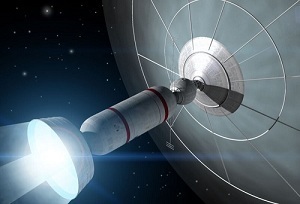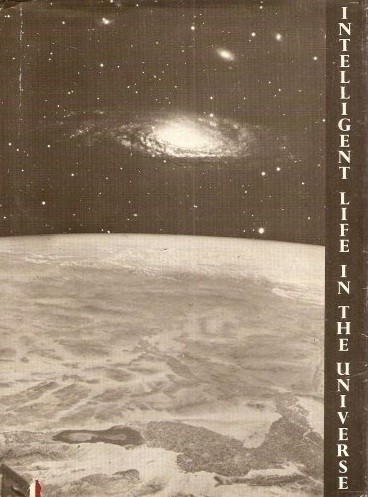Paul Gilster's Blog, page 248
March 27, 2012
Catalyzed Fusion: Tuning Up the Ramjet
Long-time Centauri Dreams readers have learned to tolerate my eccentricities (or, at least, they're kind enough not to dwell on them). One of them is my love of poking around in old books related to space travel, which is how Benjamin Field's A Narrative of the Travels and Adventures of Paul Aermont Among the Planets (1873) recently caught my eye. I don't know much about Field other than that he chose to produce this tale of interplanetary wanderings under a pseudonym, but what's fun about his tale is that after his journeys to Jupiter, Saturn, Mars and Venus are over, Field's protagonist returns to Earth to find that the planet is fully fifty years older, though he himself has aged hardly at all.
Time dilation, the reader might say, but of course Field wouldn't have known anything about special relativity. It's fun to consider, though, how an idea that in 1873 would have been simple fantasy — that someone might travel at high speed and age at a different rate than those he left behind — became in 1905 the logical outgrowth of a breakthrough theory and, by the 1960s, a publicly accepted concept. As we saw yesterday, the propagation of Robert Bussard's interstellar ramjet ideas, first through scientific papers, then through accounts of popular science and eventually science fiction (think Poul Anderson, or Larry Niven), fueled the public imagination. We'd had relativistic effects in science fiction before (as far back as 1931's Out Around Rigel, by Robert H. Wilson), but the ramjet gave the idea its vehicle.
Image: The Bussard ramjet ushered in an era of public enthusiasm for relativistic flight concepts, along with a host of unresolved issues. Credit: Adrian Mann.
I haven't mentioned the name of British researcher Anthony Martin in this context yet, but Martin, a major player in the Project Daedalus work in the 1970s, examined Bussard's ideas early in that decade and saw the possibilities of the ramscoop for deceleration. He was hardly alone in going to work on the many problems of the ramjet. Bussard spoke about fusing protons in his ramscoop engine, but subsequent analysis showed that the power needed to compress protons to fusion densities far outweighed the power that would be produced — Thomas Heppenheimer went on to demonstrate this in a 1978 paper. But three years before this, Daniel Whitmire had studied how a ramjet could draw its power through the much more energetic CNO bi-cycle (carbon-nitrogen-oxygen), a catalytic cycle that seems to be the dominant energy source in stars more than 1.3 times the mass of the Sun. Thus the 'catalytic ramjet' was born.
Adam Crowl describes the CNO bi-cycle this way in a recent post:
Basically a hydrogen fuses to a carbon-12, then another is fused to it to make nitrogen-14, then two more to make oxygen-16, which is then highly 'excited' and it spits out a helium nucleus (He-4) to return the nitrogen-14 back to carbon-12. Since the carbon-12 isn't consumed it's called a "catalytic" cycle, but it's not chemical catalysis as we know it. Call it "nuclear chemistry".
Whitmire was a friend and colleague of Al Jackson, a physicist (and these days a Centauri Dreams regular) who collaborated with Whitmire on still another ramjet idea we'll be discussing soon, a ramjet/laser hybrid. Tomorrow I'll be running a reminiscence by Al about Whitmire's work on the catalytic ramjet, along with some thoughts from a letter Bussard himself wrote to Whitmire. For today, though, we focus on catalytic fusion, in which 12C or 20Ne (isotopes of carbon and neon respectively) are the fusion catalysts. Whitmire worked through reaction sequences for each and found that given sufficient temperatures, the reaction rates were far higher than for uncatalyzed proton/proton fusion (in fact, 1018 to 1019 times higher).
The problem with Bussard's original idea is that the rate of proton-proton fusion is low. Consider that the Sun generates something less than 1 watt per cubic meter as averaged over its whole volume, considerably weaker than the energy production taking place in a light bulb filament. We get huge energy output because the Sun is vast, occupying a volume more than one million times that of Earth. The need for something more energetic aboard the relatively limited confines of the Bussard starship was clear. Either that or the ship would grow huge: Whitmire calculated that if a working proton-proton reactor were built around Bussard's ideas, it would have to be on the order of 7000 kilometers across, making for one gigantic vehicle! As Whitmire wrote:
This problem was recognized in Bussard's original work, but no viable alternative to the PPI [proton-proton] chain has yet been suggested. Here we show that the problem of the slow PPI rate can be resolved in principle by exploiting a proton burning catalytic cycle similar to the well known CNO BiCycle occurring in sufficiently hot main sequence stars. The catalyst "fuel" can be taken along since it is not depleted, but the ultimate source of energy is the interstellar hydrogen. The slowest links in the catalytic chains will be found to be 1018 – 1019 times faster than the PPI rate at an ion temperature of 86 keV and number density of 5 x 1019 cm-3.
We should note that Bussard was impressed with Whitmire's work and saw catalytic fusion as the solution to the proton-proton problem, a point he makes in the letter I'll be quoting tomorrow. Even so (and Gregory Matloff makes this point in The Starflight Handbook), these reactions are about a million times slower than the deuterium-deuterium reaction, so ramjet fusion remains more than a little problematic.
There are numerous issues with the Bussard ramjet, and Whitmire would go on to look at how interstellar ions could be collected through the combination of electric and magnetic fields, with the ramscoop's efficiency enhanced by firing laser beams to ionize hydrogen atoms ahead of the vehicle (Matloff and A.J. Fennelly were working on forward-firing lasers for ramjets at more or less the same time). We've seen as well how Robert Zubrin and Dana Andrews analyzed the ramjet and found its scoop actually created more drag than thrust, but there are those who continue to study it, believing with Whitmire that "…it would be premature to discount the fusion ramjet as a potentially viable means of relativistic interstellar spaceflight, especially for technological civilizations within or sufficiently close to nebular regions of the galaxy."
The paper is Whitmire, "Relativistic Spaceflight and the Catalytic Nuclear Ramjet," Acta Astronautica 2 (1975), pp. 497-509.






March 26, 2012
A Brief Window: The Bussard Ramjet in the 1960s
It's fascinating to watch how expansive ideas take hold in the public imagination. The idea of a starship that could scoop up particles from the interstellar medium came to Robert Bussard while he was at Los Alamos Scientific Laboratory and, as we saw recently in our articles on slowing down a starship, became the basis for subsequent magsail concepts because Bussard's design evidently generates far more drag than effective thrust. But before the problems of the design became widely known, Walter Sullivan, a writer for the New York Times, had brought the ramjet into play for future human journeys to the stars in a book called We Are Not Alone (definitely not the same book as the 2011 title by Dirk Schulze-Makuch).
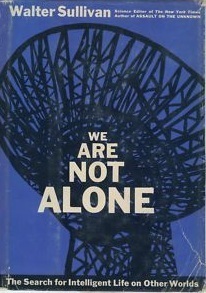
Subtitled 'The Continuing Search for Extraterrestrial Intelligence' in its latest revision, the original 1964 book was written at a time when SETI was an infant discipline (although the later revision goes through the Drake equation and places SETI in the context of developing theories of astrobiology). In 1964, Drake's Project Ozma forays were only four years old and, for all we knew, SETI might make a breakthrough any time. When one pondered the possibilities of human journeys to the stars, perhaps encountering one of those extraterrestrial civilizations that SETI might reveal, Sullivan turned to the Bussard ramjet as a potential enabling technology.
This was the same year that Stephen Dole's RAND Corporation study Habitable Planets for Man was released as a popular title called, simply, Planets for Man, co-written with Isaac Asimov. Dole and Asimov would have known about Bussard's ideas, although they don't mention them by name in the book. But in a brief chapter called 'Star Hopping,' the authors describe a program of exploration through robotic probes leading to human missions, noting the useful effects of time dilation at extreme velocities:
At velocities approaching the speed of light…, relativistic time-contractions become quite evident, so that for a particular round trip considerably less time would seem to have elapsed for the traveler himself than for an Earthbound observer. Thus, enormous distances (from the viewpoint of the Earthbound observer) could be traversed in 20 years (from the standpoint of the traveler) if velocities very close to the speed of light are attainable.
Published by Random House and with the eye-catching Asimov's name on the cover, Planets for Man brought the concept of interstellar migration front and center and, coupled with Sullivan's curiosity about extraterrestrial life, kept the public engaged with ideas of extreme technologies enabling star journeys. The other key title of the era was the 1966 book Intelligent Life in the Universe, by Russian astronomer and astrophysicist Iosif S. Shklovskii and Carl Sagan. Like Planets for Man, this title has an extended history. Shklovskii had written the original in Russian, a volume whose title translates as 'Universe, Life, Intelligence' in 1962. Sagan came in as co-author for the 1966 release, adding new material that Shklovskii then commented on.
The book is a classic, fascinating in large measure because of the way it was assembled, with a core text enriched by a series of annotations, clarifications and new material, with later additions by the original author — we see two keen minds pushing back the frontiers of thinking on extraterrestrial life and our place in the universe. Along the way, Shklovskii and Sagan developed the idea of time dilation in terms of a spacecraft that moves at a constant acceleration as far as the mid point of its journey, then decelerates at the same rate all the way to its destination. Although it was not as widely marketed as the Sullivan or Dole/Asimov titles, Intelligent Life in the Universe showed to those who were paying attention that such accelerations allowed trips to the stars. In fact, in terms of ship-time, reaching the galactic core became a matter of just 21 years, while the Andromeda galaxy became accessible within a mere 28.
There is, of course, no going home after such journeys, unless the travelers want to return to the Earth of a remote futurity. But the idea that a human might make such a journey — or the far more likely one to a nearby star — was spreading beyond science fiction. The Bussard ramjet now enters the Shklovskii/Sagan discussion, in the context of other problematic starship ideas:
A way out of these difficulties which approaches elegance in its conception has been provided by the American physicist Robert W. Bussard, of the TRW Corporation, Los Angeles. Bussard describes an interstellar ramjet which uses the atoms of the interstellar medium both as a working fluid (to provide reaction mass) and as an energy source (through thermonuclear fusion). There is no complete conversion of matter into energy. Such a fusion reactor is certainly not available today, but it violates no physical principles. Its construction is currently being very actively pursued in research on controlled thermonuclear reactions, and there is no reason to expect it to be more than a century away from realization on this planet.
Despite their enthusiasm, Shklovskii and Sagan go on to look at the huge problems involved in creating the interstellar ramscoop and shielding its crew, even assuming the necessary proton-proton fusion reaction could be ignited and sustained. As we saw recently, follow-up work would put the entire ramjet concept into doubt while raising the prospects of using a related technology — the magsail — for deceleration. And as we'll see tomorrow, other ideas about the key fusion reaction involved in the ramjet would soon come forward. But for a brief time in the 1960s, the idea of relativistic interstellar flight became something other than an idle fancy, firing the imagination of writers and in some cases launching careers in science and astronautics.






March 23, 2012
Century of the Starship
I once thought about putting together a collection of classic papers on interstellar flight. It would start with early work by the likes of Les Shephard, Eugen Sänger and Carl Wiley (whose groundbreaking paper on solar sails appeared not in a scientific journal but in Astounding Science Fiction). The book would proceed with the key papers of Forward, Bussard and Dyson and move into papers from the Project Daedalus report, then to Matloff and Mallove and up to the present day, with a long look at the Italian solar sail work of Vulpetti, Maccone and Genta. Especially later in this period there is abundant material to choose from, and there's Alcubierre to consider, and Millis' work with the Breakthrough Propulsion Physics project.
And then there's Geoff Landis and Robert Frisbee and the closely reasoned sociological analyses of Michael Michaud and… Well, you can see what happens when you start pondering editing possibilities. The book is already growing to enormous size and I've done no more than sketch out the basic parameters. A book like this would also do well to include some science fiction, which has energized so many scientists as they ponder making their concepts real. A hybrid anthology — scientific papers mixed with science fiction — is a rare beast, though as we'll see in a minute, it's been done before.
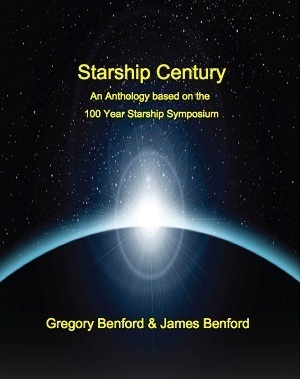
I'm glad to see that Jim and Gregory Benford think it's time to do it again, in the form of a new anthology based on the discussions at the 100 Year Starship Symposium in Orlando. Starship Century is to be the title, and the idea is to examine the ideas of current leading figures in interstellar studies — Robert Zubrin, Jill Tarter, Martin Rees, Paul Davies and many of those I've already listed above — in light of the latest developments. The 100 Year Starship Symposium is a natural trigger for this book, exploring as it did how a civilization expands into its solar system, developing the needed tools of interplanetary communications and propulsion as, in the words of Jim Benford, it "…focuses outward for its own evolution." Into the mix will be science fiction from Steven Baxter, Nancy Kress, Allen Steele, Joe Haldeman and others.
"The anthology theme is the development of starships as a key inspiring goal for future interplanetary technologies, leading to the ability to build the first starships within a century," says Gregory Benford, an award-winning science fiction author and physicist. "It addresses how future growth of an interplanetary economy can occur, leading to starships."
Starship Century will mix the fiction and the science in equal measure in a volume slated to go on sale in about a year, with additional contributors to be announced in coming months. Unlike my solely hypothetical anthology, this one will collect not historical papers but state-of-the-art science. Those of us who had the privilege of being at the conference — and I think there were a couple of thousand all told — will look forward to seeing some of the remarkable talent that appeared there pushing the discussion forward in this new venue. Although what I once described as the 'interstellar buzz' of the symposium has cooled a bit since then, we're still seeing more activity across the spectrum of interstellar studies than at any time in my memory.
I mentioned above how unusual it is to have anthologies that mix science with science fiction, but there are two exceptions that quickly prove the rule. The first is a volume edited by Arthur C. Clarke called Project Solar Sail (New York: Roc, 1990). This chunky paperback should be on your shelf, containing as it does fiction by David Brin, Clarke himself ("The Wind from the Sun"), Larry Niven and others as well as papers by Eric Drexler, Robert Forward and Louis Friedman. There's the obligatory nod to Tennyson ("Saw the heavens filled with commerce / Argosies of magic sails") and a longer attempt at sail poetry by Ray Bradbury and Jonathan V. Post.
We also have a book called Going Interstellar, edited by MSFC's Les Johnson and science fiction writer Jack McDevitt, coming up for publication in May, and although I don't have the contents list, I do know this one is also going to mix essays by space scientists and engineers with science fiction from a variety of authors. We have much to look forward to in the coming year or so as the echoes of the 100 Year Starship Symposium continue to resonate, and the hope here is that the synergy between science and science fiction that animates Starship Century reflects a growing public enthusiasm for our prospects in the Solar System and beyond.






March 22, 2012
Crowd-Funding the Exomoon Hunt
I've been trying to figure out why exomoons — moons around planets that orbit stars other than our own — have such a fascination for me. On the purely scientific level, the sheer amazement of discovery probably carries the day, meaning that I grew up in a time long before we had confirmation of any exoplanets, and now we're talking about getting data on their moons. But there's also that sense of the exotic, for we can wonder whether gas giants in the habitable zone, which may be more plentiful than we realize, might have life on their own rocky moons.
David Kipping (Harvard-Smithsonian Center for Astrophysics) has been a key player in the exomoon hunt for some time now (search under his name in the archives here and you'll retrieve articles going back for years). David is now working with a 'crowd-funding' source called Petridish.org to fund a new mini-supercomputer that will go to work on the Hunt for Exomoons with Kepler (HEK) project. The idea behind HEK is to use Kepler data to look for transit timing variations (TTV) and transit duration variations (TDV), perturbations in the motion of the host planet that should flag the presence of a large exomoon. The detection of exomoons down to 0.2 Earth masses seems feasible with these methods, as Kipping has determined in earlier work.
Help us find the first exomoon is getting plenty of attention. The beauty of Petridish.org is that it lets individuals become a part of science one project at a time, playing an important role in the kind of things that get funded. Have a look at the site and you'll see a wide range of projects ranging from a study of wolf populations on Isle Royale National Park (Lake Superior) to the collection of rock samples in Antarctica. Each project has a short video explaining the work at hand and the funding goal, along with the rewards for donors, which could be souvenirs of some kind or, for large donations, having the project named after the donor. Needless to say, backers are also on the fast track for updates on the research.
With over 1000 new planetary candidates just released by Kepler, the exomoon possibilities are getting more and more interesting, but Kipping points out that hunting for a single moon takes about 6 years of computer time:
Searching for moons requires the most sophisticated statistical techniques, many of which we have borrowed from cosmologists studying the Big Bang and dark energy. The systems we model have complex dynamical interactions and produce strange, asymmetric light curves requiring a lot of computer power. But we are *almost* there. A mini-supercomputer would have a huge impact on our search, so please do consider supporting us!
The fund-raising project still has eleven days to run and is making excellent progress. But faster computer processors would bump up the speed for HEK's work, and with almost two weeks to go, Kipping is hoping the project can not only acquire the needed machine but upgrade it to state-of-the-art standards. Have a look at what HEK is doing with crowd-funding, and be aware, too, of Kipping's paper "The Hunt for Exomoons with Kepler (HEK): I. Description of a New Observational Project," available on the arXiv site and now accepted for publication in The Astrophysical Journal. For more on HEK, see the Centauri Dreams post New Exomoon Project Will Use Kepler Data.






March 21, 2012
Starship Surfing: Ride the Bow Shock
We've been looking at slowing down a starship, pondering ways the interstellar medium itself might be of use, and seeing how the stellar wind produced by the destination star could slow a magsail. A large solar sail could use stellar photons, but the advantage of the magsail is that it's going to be effective at a greater distance, and we can also consider other trajectory-bending effects like the Lorentz turning studied by Robert Forward and P.C. Norem. But if you take a look at the relevant papers on magsails and other uses of the medium, you'll find that they all assume the interstellar medium is more or less uniform. We know, of course, that it is not.
For one thing, the Sun itself seems to be near the boundary of the Local Interstellar Cloud, and there are a number of such clouds within about 5 parsecs of the Solar System. In fact, we're not exactly sure whether the Sun is just outside the LIC or barely within it. In any case, as Ian Crawford has pointed out, Centauri A and B appear to be outside of the LIC in the direction of the G cloud, yet another denser region of the local interstellar medium. Although Robert Bussard assumed densities of about 1 hydrogen atom per cubic centimeter for his ramjet, a starship between denser clouds may encounter far less, perhaps 0.01 hydrogen atoms in the same volume.
The other wildcard is the fact that leaving and approaching a stellar system, we encounter the kind of interesting effects shown in the image below. This is anything but a uniform interstellar background. The bubble created by the solar wind is called the heliosphere, at the outer boundary of which is the heliopause (here the solar wind is balanced by inward pressure from the interstellar medium), and as you can see in the diagram, the bow shock forms on the outer edge as the star moves through the ionized gases of the medium. Still within the heliosphere is the region called the termination shock, where the speed of the solar wind is abruptly reduced — between the termination shock and the heliopause is the area known as the heliosheath.
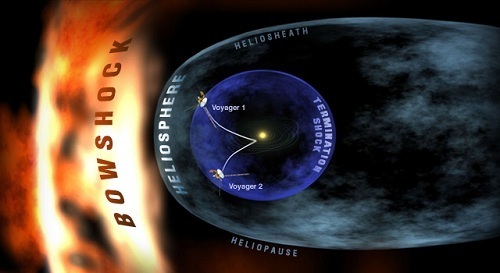
Image: The complicated interactions between the Sun and the local interstellar medium. Credit: NASA/JPL.
Physicist and writer Gregory Benford calls the bow shock, that bumper of plasma and higher density gas that forms 100-200 AU from the star, "the obvious place to decelerate." Obvious it may be, but I haven't encountered the idea in the literature before, and it's an ingenious enough notion that I suspect we'll be seeing a paper or two on the matter before long. The suddenly higher density and plasma content available here should allow interesting maneuverability along the lines of the Lorentz force turning that Forward and Norem studied for course correction and round-trip missions. The bow shock should also offer prime ground for deceleration.
We have early data on the termination shock from Voyager 2, which crossed it at 84 AU back in 2007, while Voyager 1 entered the heliosheath at 94 AU in 2004, and Benford figures the plasma density increase at the bow shock should be one to two orders of magnitude above the interstellar density, and that means one or two orders of magnitude more deceleration. I want to quote him on this from a recent email:
My main point is that these are 3D structures, so a starship could navigate through them using the Forward I x B torque model which steers without decelerating. Each of the bow shock, heliopause and termination shocks are surfaces one can sail on and in, maximizing the deceleration.
So here is the method for the star sailors of the far future:
I imagine that any trial of a starship in, say 100 years, will begin with expeditions into the several hundred AU shock environment, have a look at distant iceteroids and maybe dwarf stars. Then turn back and try to decelerate using magsail skills on the shock surfaces available. (I surf, and this is like inverse surfing, using natural wave phenomena to slow.) Develop the tech and skills to sail the interstellar seas!
As a starship approaches a star, sensing the shock structures will be like having a good eye for the tides, currents and reefs of a harbor.
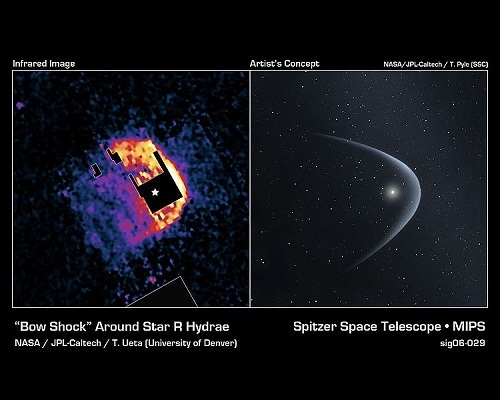
Image: Spitzer image and artists conception of the bow shock around R Hya. Credit: NASA/JPL, Toshiya Ueta.
Now we can look at certain astronomical images in a new light, as witness the Spitzer imagery and subsequent artist's concept above. This is the star R. Hydrae in infrared, showing the bow shock about as well defined as I have ever seen it. Approaching a star using these decelereation methods would involve a long period of braking moving through and along the bow shock, heliopause and termination shock, staying within the high density plasma to take advantage of the increased densities there with the starship's magsail fully deployed. After the long spiral into the inner system, continued magsail braking or perhaps inner system braking using a solar sail would allow the vehicle to maneuver and explore the new solar system.






March 20, 2012
Interstellar Space: Uses of the Medium
One of the first things we need to do in terms of interstellar exploration is to get a spacecraft built for the purpose to travel outside the heliosphere and give us solid measurements on the interstellar medium. The Voyagers are doing their best but they were never designed for what has become their interstellar mission, and while we can marvel at their longevity, it's with the knowledge that their resources are few and their years of useful data gradually drawing to an end. Something along the lines of Ralph McNutt's Innovative Interstellar Explorer would do the job nicely, allowing us to sample the environment that much longer missions will have to work in.
Lorentz Force Turning
The interstellar medium (ISM) is important not just because we have to learn about things like shielding a fast-moving spacecraft and cosmic ray flux but also because we may be able to use some aspects of the medium for deceleration. Yesterday's discussion of magsails reminded me of a 1969 paper by P. C. Norem that took a truly round-about way to stop a laser-beamed lightsail at a destination star. Norem was interested in what we can call 'thrustless turning,' an idea Robert Forward explored in a 1964 paper (thanks to Gregory Benford for sending the Forward document, my copy of which had disappeared somewhere in the wilds of my office).
Norem's notion was to send his spacecraft on a trajectory taking it far beyond the target star, using long wires and an electrical charge induced on the spacecraft to allow interactions with the interstellar magnetic field to cause it to turn. The vehicle would actually approach the star from behind (as seen from Earth), allowing a laser beam from Earth to slow it for system entry and exploration. The idea takes advantage of the fact that a charged object moving through a magnetic field experiences a Lorentz force at right angles to its direction of motion and the magnetic field itself. You can see why this would be attractive to those hoping to use the local interstellar medium to accomplish what would otherwise require massive propulsion systems.
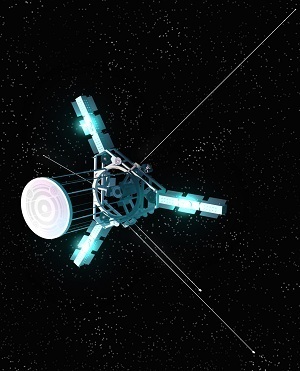
Norem was able to extend the idea into a concept for a round-trip mission, because he realized that he could once again accelerate his laser-sail by turning on the beam from Earth. Coming up to cruise, the craft (now moving away from Earth) would again use Lorentz turning to make the needed 180 degree maneuver that would put it on a trajectory back to our planet. Final deceleration into the home system would be with the sail deployed against the same laser beam.
Image: An early concept for the Innovative Interstellar Explorer probe to the interstellar medium. Credit: JHU/APL.
Forward hadn't worked out the laser sail ramifications as early as 1964, but he thought thrustless turning was a workable mechanism, one powerful enough, by his calculations, to allow not only for mid-course corrections but in some cases to return a small probe to Earth after its journey, in which case we have the odd situation in which the energy required to launch a flyby probe to a star is also the energy needed to fly a round-trip probe. Inspired by Norem, he might have considered deploying a thrustless turning system on some of his own designs, but I imagine that the idea of tripling the mission time, which is what would have happened, for instance, on one of his hypothetical Barnard's Star laser sail missions, may have led him to drop the idea.
Powering Up the Spacecraft
But the notion persists that the interstellar medium is supple and useful if we can learn how to take advantage of it. We also need a lot more data — Forward noted that his 1964 calculations could be carried out only to 20 percent accuracy because parameters like the strength of the interstellar magnetic field were not yet known. But the physics of thrustless turning as applied to an interstellar mission are well worth considering as we continue working on future missions to the ISM. Here's Forward's overview of the idea in terms of technology:
In order to use this force in space effectively, it is necessary to find an efficient lightweight method of maintaining a substantial charge on a space vehicle in spite of the discharging effects due to field emission and ion capture from the surrounding regions. It is shown in the following sections that the concept is quite feasible for probes or vehicles in interstellar space, whereas it would not work in interplanetary space because of the high ion densities near the sun. By using a long, thin quartz fiber to increase the capacitance of the probe, the charge-to-mass ratio can be made very large without having to use high voltages. This, in turn, means that the necessary voltage and current can be obtained from a few grams of a suitable radioisotope or a very small charged particle acceleration.
Gregory Matloff considers thrustless turning in his book Deep Space Probes (2nd edition, Springer, 2005), where the charge carried by the spacecraft is generated by the decay of radioactive isotopes. He notes that a starship of any substantial size would demand an enormous electrostatic charge to make the turning maneuver feasible within decades. But in a 2005 paper with Les Johnson (also kindly sent by Gregory Benford), Matloff examined the use of an electrodynamic tether (EDT) to supply power to an Alpha Centauri expedition that would take 1433 years to reach its destination. In the conclusion of that paper, the authors make the case:
Electrodynamic tethers have a number of applications to interstellar travel. Consideration of a model for a sample world-ship mission through the local interstellar medium reveals that the interaction between an EDT and the interstellar magnetic field can satisfy on-board starship power requirements without an inordinate amount of starship deceleration [in other words, magnetic braking induced by the tether is found to be a minimal consideration].
Thrustless turning using an EDT's interaction with the interstellar magnetic field will allow for course correction and rendezvous of solar sail-launched modules in interstellar space. It will not, however, allow rapid thrustless circling to allow a starship to re-enter a power beam or make numerous solar passes.
Lorentz force turning turns out to be slow and power-demanding, and maintaining the charge is also an issue because interstellar ions of opposite charge will be attracted to the spacecraft, thus reducing the effective charge. But the work of Forward, Norem, Matloff and Johnson on thrustless turning reminds us that interactions with the medium itself may become a component of starship design, just as the magnetic sail idea — braking against a stellar wind — uses the ambient environment to do something that would otherwise demand onboard fuel. Tomorrow we'll look at a novel way of taking advantage of a star's own interactions with the interstellar medium to slow a starship, a kind of solar sailing that may reduce overall travel times.
The Norem paper is "Interstellar Travel: A Round Trip Propulsion System with Relativistic Capabilities," AAS 69-388 (June, 1969). Robert Forward's paper on Lorentz force turning is "Zero-Thrust Velocity Vector Control for Interstellar Probes: Lorentz Force Navigation and Circling," AIAA Journal 2 (1964), pp. 885-889. Matloff and Johnson write about electrodynamic tether possibilities in "Applications of the Electrodynamic Tether to Interstellar Travel," JBIS 58 (June, 2005), pp. 398-402.






March 19, 2012
Braking Against a Stellar Wind
This morning I want to pick up on the 'problem of arrival' theme I began writing about on Friday, and we'll look at interstellar deceleration issues a good bit this week. But I can't let Monday start without reference to the Icarus results from Gran Sasso that finds neutrinos traveling at precisely the speed of light. All of this adds credence to the growing belief that the earlier Opera experiment was compromised by equipment problems. The news is all over the place (you might begin with this BBC account) and while we'll keep an eye on it, I don't plan to spend much time this week on neutrinos. We still have much to get done on the subject of slowing down.
Magsails and Local Resources
When you begin to unlock the deceleration issue, the options quickly multiply, and you find yourself looking into areas that weren't remotely the subject of your earlier research. As we saw on Friday, the concept of magnetic sails grew organically out of Robert Bussard's idea of an interstellar ramjet. Bussard didn't want to slow down — he wanted to go very fast indeed. Read the comments on that post and you'll find Al Jackson's entertaining reminiscences of a dinner with Bussard (Tau Zero author Poul Anderson was present too), and a reminder that the scientist always claimed to have come upon the ramjet idea because of an encounter with Mexican food. The usual story has it that it was a burrito which, bitten down upon, suddenly opened for Bussard the splendors of matter being forced into a cylinder at high speeds.
Or maybe he was eating huevos rancheros — the story seems to have varied a bit over the years. Whatever the case, the idea of scooping up interstellar hydrogen and fusing it turned into a 1960 paper for Acta Astronautica and, along the way, into a critique by Robert Zubrin and Dana Andrews that showed just how much drag an electromagnetic scoop could generate. Andrews was working for Boeing at the time, and had grown interested in using Bussard concepts right here in the Solar System, thinking that a big enough scoop could gather hydrogen for use in an ion engine that could be powered up by an onboard nuclear reactor. A self-fueling ion drive might not be adaptable for interstellar missions, but for interplanetary work it seemed worth a look.
But the numbers were intractable. The magnetic scoop Andrews hoped to deploy created more drag than the ion engines produced thrust. The two researchers quickly found that the scoop's best function was as a magnetic sail, and their work on the idea appeared in the literature in the early 1990s. In his 1999 book Entering Space, Zubrin recalls that the time was right for the magsail given that Paul Chu (University of Houston) had just invented the first high-temperature superconductors, which a magsail could theoretically use to create the magnetic field that would allow it to ride on the solar wind. Practical high-temperature superconducting wire born out of this work might one day allow magsails to achieve higher thrust-to-weight ratios than solar sails.
Magsails have clear propulsion implications, but Zubrin states the obvious about their most effective uses:
…the most interesting and important thing about the magsail is not what it can do to speed up a spacecraft — what's important is its capability for slowing one down. The magsail is the ideal interstellar mission brake! No matter how fast a spaceship is going, all it has to do to stop is deploy and turn on a magsail, and the drag generated against the interstellar plasma will do the rest. Just as in the case of a parachute deployed by a drag racer, the faster the ship is going, the more 'wind' is felt, and the better it works.
Which takes us to the idea of using in-situ resources to tackle the deceleration problem. If your goal is to launch a starship that can decelerate in the destination system to explore it, the magsail lets you do the job without carrying the deceleration fuel aboard the vehicle. Play around with the numbers long enough and you'll see what a huge boost this would be, for otherwise you're carrying all the fuel needed to slow down a starship (moving, perhaps, at .10 c!), and that means you've got to get all of that fuel up to cruise in the first place. The idea of creating drag against the interstellar medium and a destination stellar wind thus has a powerful appeal.
Rise of the Superconductor
When Bussard studied how his ramjet could operate in a region of interstellar space where the density of hydrogen was roughly 1 hydrogen atom per cubic centimeter, he saw that he would need a collecting area of 10,000 square kilometers. This is so vast that even if it were made of 0.1-centimeter mylar, a physical scoop would weigh something on the order of 250,000 tons. But a much smaller collector generating a magnetic field seems practical given the advances in superconducting alluded to above, with a loop of superconducting wire deployed from the spacecraft, the current applied to it cycling continuously to generate the magnetic field. Here's how Zubrin and Andrews described it in a paper based on their presentation at the 1990 Vision-21 symposium at NASA's Lewis Research Center (now Glenn Research Center):
The magnetic sail, or Magsail, is a device which can be used to accelerate or decelerate a spacecraft by using a magnetic field to accelerate/deflect the plasma naturally found in the solar wind and interstellar medium. Its principle of operation is as follows: A loop of superconducting cable hundreds of kilometers in diameter is stored on a drum attached to a payload spacecraft. When the time comes for operation the cable is played out into space and a current is initiated in the loop. This current once initiated, will be maintained indefinitely in the superconductor without further power. The magnetic field created by the current will impart a hoop stress to the loop aiding the deployment and eventually forcing it to a rigid circular shape.
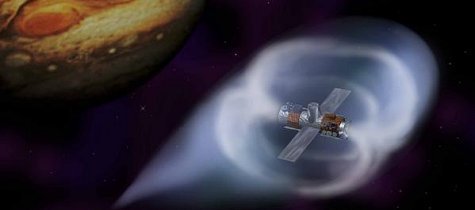
Image: A space probe surrounded by a magnetic sail. Early work on these concepts has taken place at the University of Washington under Robert Winglee, with reports available at NASA's Institute for Advanced Concepts site. Credit: NASA/University of Washington.
Thus the hybrid concept Andrews and Zubrin came up with in the Vision-21 work, extending ideas they had first presented in a 1988 paper: Use laser beaming technology to push a sail to interstellar cruise speeds, then deploy a magsail upon arrival to reduce deceleration time. The authors looked at the numbers and worked out 0.8 years for acceleration, 17.4 years of coasting at almost half the speed of light, and 18.8 years for deceleration. This gets you about 10 light years out in around 37 years, a mind-bending pace that uses a huge sail and some generous assumptions about laser power that we'll look at tomorrow. For there are other ways to use lasers, even for deceleration, and other ways, too, to exploit the local interstellar medium.
Zubrin and Andrews' paper from Vision-21 is "Use of Magnetic Sails for Advanced Exploration Missions," in the proceedings of Vision-21: Space Travel for the Next Millennium" (NASA Conference Publication 10059. The citation for their 1988 work is given in yesterday's Centauri Dreams post.






March 16, 2012
Starships: The Problem of Arrival
You wouldn't think that slowing down a starship would be the subject of a totally engrossing novel, but that's the plot device in Poul Anderson's Tau Zero (1970, though based on a 1967 short story called "To Outlive Eternity"). Anderson's ramscoop starship, the Leonora Christine, can't slow down because of damage suffered in mid-cruise. Edging ever closer to the speed of light, the crew experiences all sorts of time dilation wonders as they wrestle to regain control, and the ending, while scientifically dubious, is also in every way unforgettable. Anderson could be guilty of over-writing but few writers are gifted with his sheer imaginative sweep.
I'm thinking that coupling a ramscoop with a problem in deceleration is just the ticket for getting into the whole issue of starship arrivals. We can start with Robert Bussard's 1960 paper "Galactic Matter and Interstellar Spaceflight," which unwittingly paved the way for the whole magsail concept. Bussard came up with what for a time appeared to be the ultimate in fast transportation, a ramjet that collected interstellar hydrogen in an electromagnetic scoop thousands of kilometers in diameter as it traveled. The collected hydrogen would be used as fuel for the same kind of proton/proton fusion that powers up the Sun. Moreover, this would be an engine that would become more efficient the faster the ship went.
The Ramscoop and the Details
No wonder writers like Anderson and Larry Niven loved the idea, which fed their plots of humanity expanding into the galaxy — even Carl Sagan would point to the Bussard ramjet as a propulsion system that could get us up to a substantial percentage of the speed of light. But in the case of the ramjet, at least one of the devils in the details turned out to be bremsstrahlung radiation, which is produced when charged particles decelerate. Thomas Heppenheimer went to work on this in 1978 and found the Bussard design unworkable because the power that could be produced was dwarfed by the losses from the bremsstrahlung process.
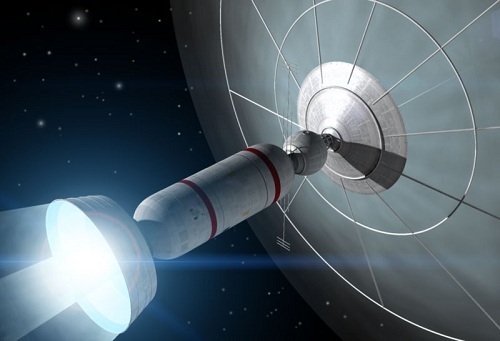
Image: The Bussard ramjet, a concept which may turn out to have more applicability in braking than acceleration. Credit: Adrian Mann.
This wasn't the end of the ramjet concept because Daniel Whitmire was able to figure out a different way to power up the engine (and in the future we'll have to talk about Whitmire and his study of the CNO cycle, which makes for a much more powerful and efficient fusion engine), but the most troublesome critique emerged in 1985 through the work of Dana Andrews and Robert Zubrin. Bussard assumed an electromagnetic scoop of vast proportions, but Andrews and Zubrin came to realize that such a scoop produced more drag than it did thrust. In fact, their work showed that when leaving a star system, a ramscoop could serve as an electromagnetic sail. Thus the magsail entered into the lexicon and we began pondering its uses.
If we can't use Bussard ramjet techniques in cruise, why not use them upon arrival? Switch on the magsail as the vehicle approaches its destination solar system and let it use the star's stellar wind to brake against. The magsail produces efficient deceleration at high velocities, but an incoming spacecraft could also deploy a conventional solar sail upon arrival for final braking and movement within the planetary system. Magsails could also be used to provide the mission's initial acceleration, pushed by a particle beam or by a stream of incoming pellets turned into plasma — Gerald Nordley has explored this concept and others germane to our purposes here.
Hybrid Starship Designs
Now we're talking hybrid approaches to interstellar propulsion. A spacecraft might achieve its initial acceleration, for example, through other forms of fusion, or perhaps through beamed microwave or laser sail technologies, while deploying the magsail for arrival. Get into the details and hybrid systems begin to make sense, because there is nothing that says you have to use the same technologies for interstellar braking as you do for the rest of the journey. But the great problem of deceleration looms over the entire topic of interstellar travel, and it behooves us to think of ways to take advantage of external braking possibilities wherever possible, unless we want to devote most of the bulk of our spacecraft to an onboard deceleration system and its fuel.
I was interested to see that John Mathews considered the deceleration question in his recent paper on self-replicating spacecraft (see Robotic Networks Among the Stars and the subsequent three entries here). Mathews is well acquainted with magsail concepts and advocates braking against the stellar wind, noting that solar sails are efficient only relatively close to the star. Where he moves us a step forward is in his idea of using electrodynamic tether technologies to generate huge amounts of energy from the spacecraft's movement through the stellar wind, powering the magsail itself and offering options for driving other devices.
The comparison of solar to magnetic sail in terms of decelerating a spacecraft is one we have to get into at more depth, so we'll continue the deceleration discussion on Monday and most of next week, for it turns out that magsail and solar sail braking are only two of the options we might consider. I want to go through all of these and offer some references for an area of the interstellar conundrum that doesn't often get the attention it deserves. Project Icarus has been pondering deceleration options too, and I'll use some of our synergy with their work to consider what might be done.
The Bussard paper mentioned above is "Galactic Matter and Interstellar Spaceflight," Astronautica Acta 6 (1960), pp. 179-194. Andrews and Zubrin's key paper on the Bussard ramjet and drag is "Magnetic Sails and Interstellar Travel," International Astronautical Federation Paper IAF-88-5533 (Bangalore, India, October 1988). Or you can read Zubrin's well written exposition of all this in Entering Space: Creating a Spacefaring Civilization (New York: Tarcher/Putnam, 1999). This one should be on your shelf in any case.






March 15, 2012
WISE: Into the Infrared Sky
As promised, we now have the infrared sky at a new level of detail thanks to the labors of the Wide-Field Infrared Survey Explorer (WISE) mission, which has now mapped (with a few slight glitches) more than half a billion objects, from galaxies to stars to asteroids and comets. We can now expect a new wave of papers from the more than 2.7 million images WISE has delivered at four infrared wavelengths and can explore the WISE atlas of some 18,000 images ourselves.
The Big Picture
But first, I want to step back and look at astronomical discovery in context, a thought spurred by Larry Klaes, who sent me a note originally posted on the HASTRO-L mailing list (by Rich Sanderson, of the Springfield Science Museum in Massachusetts). Every now and then I read something that wraps back into the past and yet implies future things, generating a sense of connection with what the enterprise is all about. Such is the case in this passage Sanderson quotes from an 1875 book by Richard Proctor that looks at 19th Century transits of Venus. Remember, these are rare phenomena, occurring in pairs spaced eight years apart which are then separated by gaps of 121.5 years and 105.5 years. Listen to Proctor:
We cannot doubt that when the transits of 2004 and 2012 are approaching, astronomers will look back with interest on the operations conducted during the present "transit season;" and although in those times in all probability the determination of the sun's distance by other methods…. will far surpass in accuracy those now obtained by such methods, yet we may reasonably believe that great weight will even then be attached to the determinations obtained during the approaching transits. I think the astronomers of the first years of the twenty-first century, looking back over the long transitless period which will then have passed, will understand the anxiety of astronomers in our own time to utilise to the full whatever opportunities the coming transits may afford; and I venture to hope that should there then be found, among old volumes in their book-stalls, the essays and charts by which I have endeavored to aid in securing that end (perhaps even this little book in which I record the history of the matter), they will not be disposed to judge over-harshly what some in our own day may have regarded as an excess of zeal.
Thus the past regards us, and in his own comment, Sanderson goes on to speculate about what's ahead:
As Proctor had hoped, a copy of his little book did appear on a "book-stall" I visited in Ithaca, New York, from which it made the journey to Massachusetts to take up residence in my library. I wonder whose fingers will be caressing its pages in 2117.
For we do have a transit coming up on June 6, but after that, it will be December of 2117 before the next, and we can only wonder not only how astronomers of that day will observe it, but also about the techniques they will then be using to study planets around other stars. We can also wonder at the kind of nearby objects we will be considering as fair game for future space probes, given the results of missions like WISE. We're learning that 'rogue' planets may be out there in huge numbers, and that brown dwarfs are interesting targets in their own right. Perhaps in the new WISE data we'll find a few objects like these to put on our exploratory wish list, even as we imagine future astronomers looking back and marveling at our primitive equipment.
Analysis and Papers Ahead
But as we begin to dig into what WISE has produced, we've already learned that the mission has now identified, according to NEOWISE principal investigator Amy Mainzer, some 93 percent of the near-Earth asteroids larger than 1 kilometer, thus satisfying the congressional mandate for the SpaceGuard project.
NEOWISE is the asteroid-hunting portion of the WISE mission. Its efforts have also found fewer mid-size objects among near-Earth asteroids than used to be thought were there. The recent discovery of 2010 TK7, the first known Earth Trojan asteroid, underscores the capabilities of NEOWISE. Trojans are asteroids that share an orbit with a planet, circling the Sun in front of or behind the planet — they circle around the stable gravity wells called Lagrange points. 2010 TK7's orbit is well known over the next 10,000 years, showing that at no time during that period will it approach any closer than 20 million kilometers to the Earth.
WISE is, of course, equally attuned to the study of distant objects, as in the image below, which shows the 'light echo' of the supernova event associated with Cassiopeia A, one of the most powerful radio sources in the sky. The light from the explosion reached the Earth around 1667 AD but seems to have gone unnoticed, probably because dust between the event and the Earth would have dimmed the explosion so as to make it all but invisible to the naked eye.
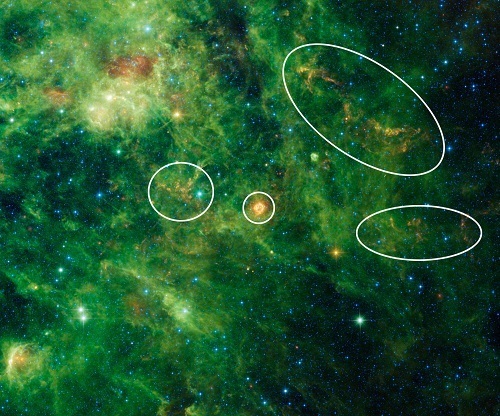
Image: The light echo of the explosion that produced Cassiopeia A. The central bright cloud of dust is the blast wave moving through interstellar space heating up dust as it goes. The blast wave travels fast – at an average speed of about 18,000 kilometers per second (11,000 miles per second) – but that is still only about 6% of the speed of light. The blast has expanded out to about a distance of 21 light-years from the original explosion. The flash of light from the explosion traveled faster – at the speed of light – covering over 300 light-years at the time that WISE took this picture. The orange-colored echoes further out from the central remnant are from dust heated as the supernova flash reached the dust centuries after the original explosion. Credit: NASA/JPL-Caltech/WISE Team.
Among the many discoveries of WISE are the Y-class brown dwarfs that are the coolest known class of stars. We now wait as the astronomical community sifts through the 15 trillion bytes of returned data in search of brown dwarfs and other interesting IR signatures in nearby space. The WISE all-sky archive with catalog and image data is available online along with instructions.






March 14, 2012
Thoughts on Antihydrogen and Propulsion
Normally when we talk about interstellar sail concepts, we're looking at some kind of microwave or laser beaming technologies of the kind Robert Forward wrote about, in which the sail is driven by a beam produced by an installation in the Solar System. Greg and Jim Benford have carried out sail experiments in the laboratory showing that microwave beaming could indeed drive such a sail. But Steven Howe's concept, developed in reports for NASA's Institute for Advanced Concepts, involved antimatter released from within the spacecraft. The latter would encounter a sail enriched with uranium-235 to reach velocities of well over 100 kilometers per second.
That's fast enough to make missions to the nearby interstellar medium feasible, and it points the way to longer journeys once the technology has proven itself. But everything depends upon storing antihydrogen, which is an antimatter atom — an antiproton orbited by a positron. Howe thinks the antihydrogen could be stored in the form of frozen pellets, these to be kept in micro-traps built on integrated circuit chips that would contain the antihydrogen in wells spaced at periodic intervals, allowing pellets to be discharged to the sail on demand. The storage method alone makes for fascinating reading, and you can find it among the NIAC reports online.
Of course, we have to create the antihydrogen first, a feat achieved back in 2002 at CERN through the mixing of cold clouds of positrons and antiprotons. And it goes without saying that before we get to the propulsion aspect of antihydrogen, we have to go to work on the differences between hydrogen and antihydrogen, while investigating the various kinds of long-term storage options that might be used for antimatter. Does antihydrogen have the same basic properties as hydrogen? CERN is moving on to study the matter, with new work showing the amount of energy needed to change the spin of antihydrogen's positrons.
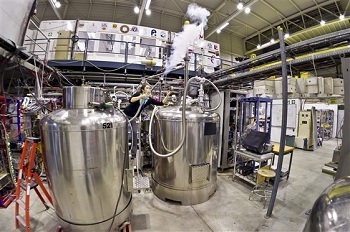
The report comes from CERN's Antihydrogen Laser Physics Apparatus (ALPHA) experiment, the same team that trapped antihydrogen for over 1000 seconds last year. Successful trapping now allows the analysis of the antihydrogen itself, applying microwave pulses to affect the magnetic moment of the anti-atoms. This BBC story quotes ALPHA scientist Jeffrey Hangst:
"When that happens, it goes from being trapped like a marble in a bowl to being repelled, like a marble on top of a hill," Dr Hangst explained.
"It wants to 'roll away', and when it does that, it encounters some matter and annihilates, and we detect the fact that it disappears."
Image: The ALPHA experiment facility at CERN. Credit: Jeffrey Hangst/CERN.
The work is part of a much larger program that will probe antihydrogen with laser light, the goal being to explore the energy levels within antihydrogen. What the work may eventually uncover, perhaps in addition to tuning up our methods of antihydrogen storage along the way, is whether there are clues in the makeup of antihydrogen that explain why the universe is filled with matter and not its opposite, given that both matter and antimatter existed in equal amounts in the earliest moments of the universe. The light emitted as an excited electron returns to its resting orbit is well studied in hydrogen and assumed to be identical in its antihydrogen counterpart.
These are early results that promise much, but the important thing is that the ALPHA team has demonstrated that their apparatus has the capability of making these measurements on antihydrogen. Uncovering the antihydrogen spectrum will take further work but could prove immensely useful in our understanding of the simplest anti-atom. We're a long way from the antimatter sail concept, but Howe's Phase II report at NIAC covered his own experiments with antiprotons and uranium-laden foils, critical work for fleshing out the architecture for a mission that may one day fly once we've mastered antihydrogen storage and learned to produce the needed milligrams of antimatter (current global production is measured in nanograms per year).
Antimatter's promise has always been bright, given that 10 milligrams of the stuff used in an antiproton engine (not Howe's sail) heating hydrogen through antimatter annihilation would produce the equivalent of 120 tons of hydrogen/liquid oxygen chemical fuel. But as soon as you start talking about the energy involved, the difficulty in producing and storing antimatter puts a damper on the entire conversation. That's one reason why, at a time when antimatter costs in the neighborhood of $100 trillion per gram, finding natural antimatter sources in space is such an interesting possibility. It was just last year that we learned about the inner Van Allen belts' roll in trapping natural antimatter, and James Bickford (Draper Laboratory, Cambridge MA) has been examining more abundant sources farther out in the Solar System.
The CERN work is reported in Amole et al., "Resonant quantum transitions in trapped antihydrogen atoms," published online in Nature 9 January 2012 (abstract). For more on antimatter sources in nearby space, see Adriani et al., "The discovery of geomagnetically trapped cosmic ray antiprotons," Astrophysical Journal Letters Vol. 37, No. 2, L29 (abstract / preprint). I discuss the recent results from the Pamela satellite (Payload for Antimatter Matter Exploration and Light-nuclei Astrophysics) and provide sources for Bickford's continuing work on naturally occurring antimatter in Antimatter Source Near the Earth.






Paul Gilster's Blog
- Paul Gilster's profile
- 7 followers


